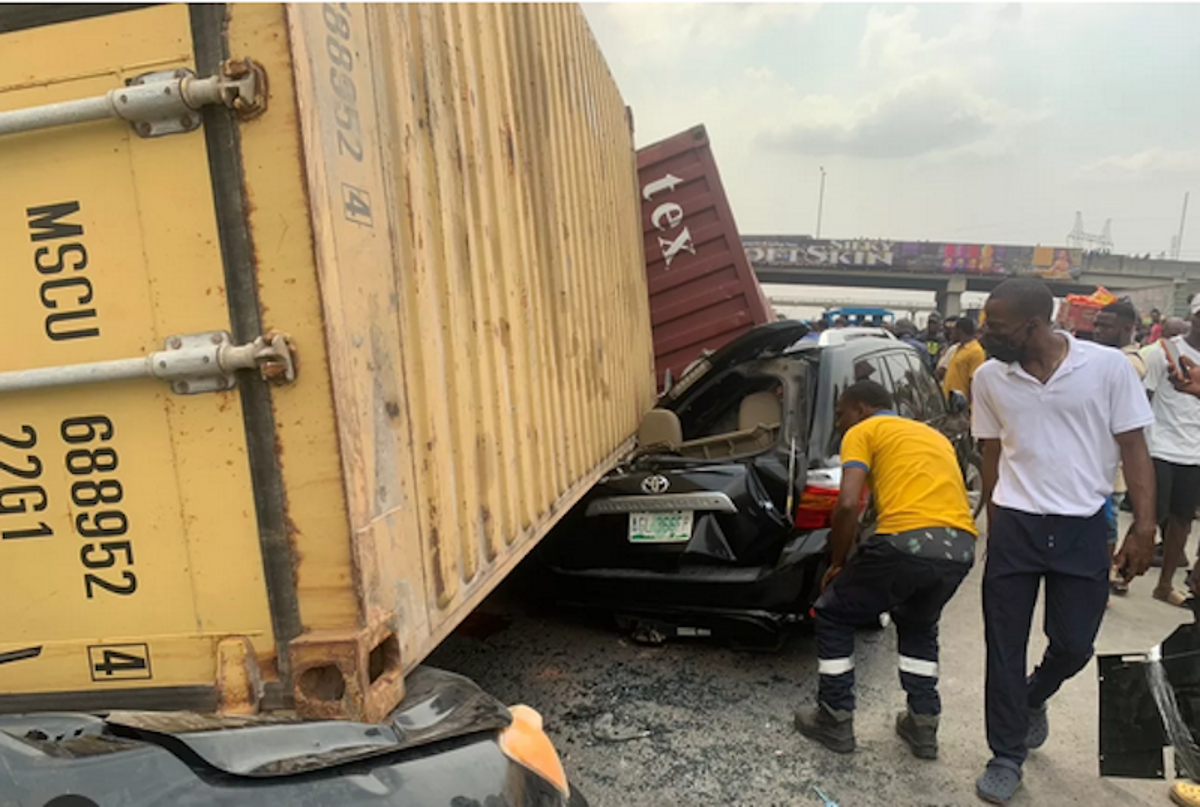Tame cargo container accidents now
A recent flurry of falling cargo container trucks has generated sharp public responses, especially in the light of the fatalities that follow such accidents. Recently, three of such incidents occurred within four days in and around Lagos, with the most horrendous being that on the Ojuelegba Bridge on the last day of January this year. The […]

cargo accident in nigeria
A recent flurry of falling cargo container trucks has generated sharp public responses, especially in the light of the fatalities that follow such accidents. Recently, three of such incidents occurred within four days in and around Lagos, with the most horrendous being that on the Ojuelegba Bridge on the last day of January this year. The container fell off the flyover and onto a minibus on the road below and killed nine persons and injured many others.
Just two days after, another incident of a container falling off a vehicle took place at the Dopemu area Lagos. Again, two days later, another incident took place, this time in the Oshodi area of Lagos, with damages and casualties.
A highlight of the Ojuelegba incident was that a family of four perished in it, even as the Governor of Lagos State, Babajide Sanwo-Olu, directed that the driver of the truck should be arrested and prosecuted, just as the Federal Road Safety Corps (FRSC) commenced an investigation to ascertain why and how the barriers on the bridge restricting use by heavy duty trucks were removed.
Meanwhile, beyond the Lagos incidents have been several others in different parts of the country, which are mostly unreported, in which human lives and property are damaged. And just as the FRSC ascribed the Ojuelegba incident to human error, so are most of the other incidents traceable to the same causative factor; and that is where the problem lies.
Ordinarily, shipping containers were introduced to provide more convenience in moving cargo around the world and across different modes of transportation. However, they are designed to be moved with a well-established guarantee for security of their contents and flexibility in handling, as well as safety and convenience of society.
All over the world, container traffic is also highly regulated given the inherent risks associated with the venture. At least two grounds dictate the need for extreme caution with respect to transporting cargo containers. In the first place is the consideration for size and weight. As typical containers come in lengths of weight as much as 30 tonnes, dead weight and even mobilise more force when in motion, the need for control becomes imperative. This is because any contingency en route offers significant challenges as they cannot be moved easily except with specialised cranes.
Secondly, many of such containers convey materials and equipment that need to be restricted from contact with the public. Hence such also needs to be conveyed with utmost caution in consideration of public safety. The standard consideration for safety is directed at ensuring public good at all times. That is why it should be considered an aberration to have container accidents in city centres.
In the light of the foregoing, therefore, the need for more discretional management of the human factor becomes critical, as a wide cross section of drivers of articulated vehicles, including container trucks, operate without scruples and hence are potential killers on the roads. For instance, it is a common sight at the country’s numerous motor parks and garages to find drivers of heavy duty trucks guzzling copious quantities of alcoholic drinks and drugs in the mistaken belief that such indulgences would make them alert and bold on the roads.
Whereas there are extant rules and procedures governing the traffic of containers, the recent up-surface in their occurrences indicates significant lapses in the oversight function of the government over the operators. That is why there needs to be a rethink on the management of container traffic regime across the country. With the expansion of both domestic and foreign trade within the country and with neighbouring countries, cargo containerisation is expanding, with the prospect of more container traffic in the country.
With respect to the review of the rules and procedures governing container trucks, the areas that need uncompromised attention include the technical condition of the conveying vehicles and the state of mind of the drivers. In most instances, the vehicles that convey the containers are rickety and ill-maintained, thereby predisposing them to frequent breakdowns. Just as well is the unacceptable practice whereby containers are transported without latching them firmly to the carrying vehicles. Such a situation constitutes patent danger to the public for which the perpetrators deserve their day in court.
In the light of the rising danger of container accidents, it is not out of place for the FRSC to consider mandatory alcohol and drug tests on suspected drivers of these trucks. Just as well is the need to re-energise the effort of the agency in respect of better surveillance of container trucks and the associated traffic.
Also, specific roads and times should be provided for such trucks so that they do not move during heavy traffic so that casualty figures will be minimal in the event that an accident occurs. This issue must be treated as a priority to save road users.
